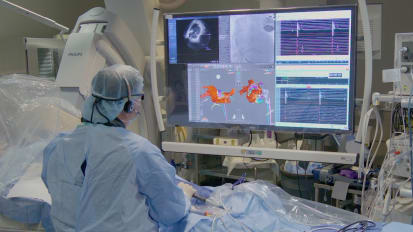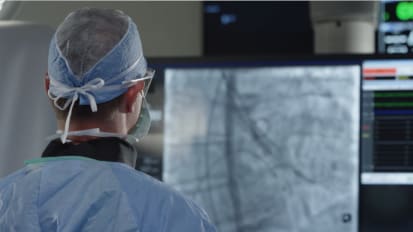[MUSIC PLAYING]
KONSTANTINOS BOUDOULAS: ECPR is a protocol that we develop with Columbus Fire Department that starts from the field.
ERNEST MAZZAFERRI JR: Columbus fire approached us because they have this new automated CPR device. And we were trying to figure out how we can incorporate it into a clinical protocol, and how to maybe save lives. So after some time discussing it, we decided that we could use these automated CPR devices to bring people directly to the cath lab and put them on the heart-lung bypass machine and take somebody who had no chance of survival and giving them a significant chance of survival to discharge.
KONSTANTINOS BOUDOULAS: The key to this is patients who have a refractory ventricular fibrillation or tachycardia, that you cannot check them back into a normal rhythm. So that's why we set up a protocol with the Columbus Fire Department that after three shocks if the patient is still in refractory ventricular fibrillation or tachycardia, you cannot get them back to normal rhythm, this protocol, we escalate. The key though. Is from the field to the cath lab, that you have good CPR. And to be able to do that, you need an automated CPR device to help perfuse the body and essential organs and brain.
ERNEST MAZZAFERRI JR: Getting people directly to the cath lab is critically important, because the more time we wait, the more damage is done to the heart, the more damage is done to all of your organs, including your brain. So that's why we have this protocol with Columbus Fire to bring them directly to the cath lab for this procedure.
KONSTANTINOS BOUDOULAS: We place the patient on the ECMO machine. Once the patient is stabilized on ECMO, we then go ahead and proceed with a heart catheterization to look for a reversible cause of their ventricular fibrillation or tachycardia-- essentially for a blocked artery that we can open up with a stent.
BRYAN WHITSON: ECMO is for extracorporeal membrane oxygenation. It's essentially a miniaturized heart-lung bypass machine, like what one might use in the operating room for cardiac surgery.
ERNEST MAZZAFERRI JR: This is a new application of an old device, which is this heart-lung bypass machine. This is a new protocol that hopefully people will start doing this in all communities around the United States and save lives.
KONSTANTINOS BOUDOULAS: Yeah. This is a very exciting protocol that we have, the ECPR. We essentially have taken patients with an essentially zero survival and have established this program, to now we have about a 30% to 40% survival. It essentially has given patients a chance to survive after having a cardiac arrest in the field.







